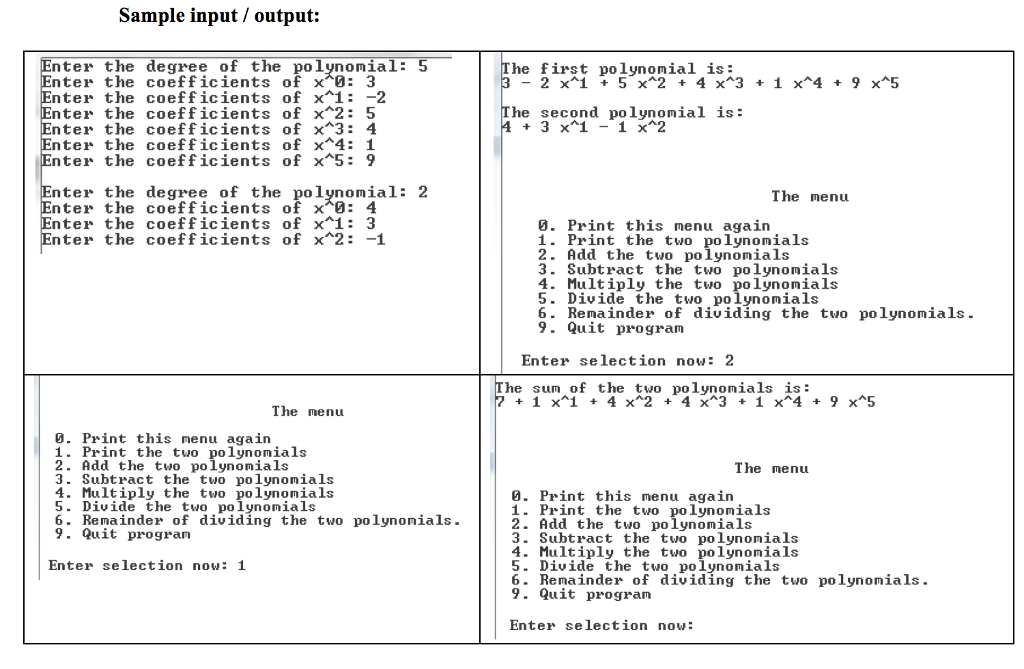Question
Create a class called polynomial for performing arithmetic with polynomials. The class can be used to add, subtract, multiply, divide, finds the remainder of two
Create a class called polynomial for performing arithmetic with polynomials. The class can be used to add, subtract, multiply, divide, finds the remainder of two polynomials.
code:
#include
#include
using namespace std;
class polynomial
{
friend ostream& operator
friend istream& operator>>(istream& isObject, polynomial& cObject);
public:
void set(int, double*);
int getDegree() const;
double* getPointer() const;
polynomial operator+(const polynomial&) const;
polynomial operator-(const polynomial&) const;
polynomial operator*(const polynomial&) const;
polynomial operator/(const polynomial&) const;
polynomial operator%(const polynomial&) const;
polynomial& operator=(const polynomial&);
polynomial(const polynomial &otherObject);
polynomial(int, double*);
polynomial();
~polynomial();
private:
int degree;
double *p;
};
void printMenu();
int main()
{
polynomial poly1, poly2;
polynomial polyAdd, polySub, polyMult, polyDiv, polyRemainder;
int selection = 0;
cin >> poly1;
cin >> poly2;
while (true)
{
system("cls");
cout
switch (selection)
{
case 0:
printMenu();
break;
case 1:
cout
cout
cout
cout
printMenu();
break;
case 2:
polyAdd = poly1 + poly2;
cout
cout
printMenu();
break;
case 3:
polySub = poly1 - poly2;
cout
cout
printMenu();
break;
case 4:
polyMult = poly1 * poly2;
cout
cout
printMenu();
break;
case 5:
polyDiv = poly1 / poly2;
cout
cout
printMenu();
break;
case 6:
polyRemainder = poly1 % poly2;
cout
cout
printMenu();
break;
case 9:
cout
return 0;
default:
cout
printMenu();
}
cin >> selection;
}
}
void printMenu()
{
cout
cout
cout
cout
cout
cout
cout
cout
cout
cout
}
void polynomial::set(int nDegree, double *q)
{
degree = nDegree;
p = new double[degree+1];
assert(p != NULL);
for(int i=0; i
p[i] = q[i];
}
int polynomial::getDegree() const
{
return degree;
}
double* polynomial::getPointer() const
{
return p;
}
polynomial& polynomial::operator=(const polynomial &pObject)
{
}
polynomial polynomial::operator+(const polynomial &pObject) const
{
}
polynomial polynomial::operator-(const polynomial &pObject) const
{
}
polynomial polynomial::operator*(const polynomial &pObject) const
{
}
polynomial polynomial::operator/(const polynomial &pObject) const
{
}
polynomial polynomial::operator%(const polynomial &pObject) const
{
}
polynomial::polynomial(int nDegree, double *q)
{
set(nDegree, q);
}
polynomial::polynomial(const polynomial &pObject )
{
}
polynomial::polynomial()
{
degree = 0;
p = new double[degree+1];
assert(p != NULL);
p[0] = 0;
}
polynomial::~polynomial()
{
delete [] p;
p = NULL;
}
ostream& operator
{
}
istream& operator>>(istream& isObject, polynomial& cObject)
{
}

Sample input / output: nter the degree of the polynomial: nter the coefficients of x 0: 3 nter the coefficients of x^1: -2 nter the coefficients of x 2: 5 nter the coefficients of x 3 4 nter the coefficients of x4: 1 nter the coefficients of x 5: 9 he first polynomial is: he second polynomial is: nter the degree ofthe polynomial: 2 nter the coefficients of x0: 4 nter the coefficients of x1 3 nter the coefficients of x2: -1 The menu d. Print this menu again 1. Print the two polynomials 2. Add the two polynomials 3. Subtract the two polynomials 4. Multiply the two polynomials 5. Divide the two polynomials 6. Remainder of dividing the two polynomials 9. Quit program Enter selection now 2 he sum of the two polynomials is: +1^1 +4^2 + 4x^3 + 1 x^4 + 9 x*S The menu 0. Print this nenu again 1. Print the to polynomials 2. Add the two polynomials 3. Subtract the two polynomials 4. Multiply the two polynomials 5. Divide the two polynomials 6. Remainder of dividing the two polynonials. 9. Quit progran The menu 0. Print this menu again 1. Print the two polynomials 2. Add the two polynomials 3. Subtract the two polynonials 4. Multiply the two polynonials 5. Divide the two polynonials 6. Remainder of dividing the two polynomials. 9. Quit program Enter selection now: 1 Enter selection now
Step by Step Solution
There are 3 Steps involved in it
Step: 1

Get Instant Access to Expert-Tailored Solutions
See step-by-step solutions with expert insights and AI powered tools for academic success
Step: 2

Step: 3

Ace Your Homework with AI
Get the answers you need in no time with our AI-driven, step-by-step assistance
Get Started


